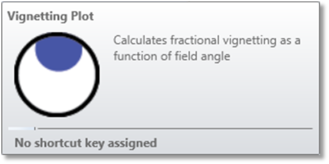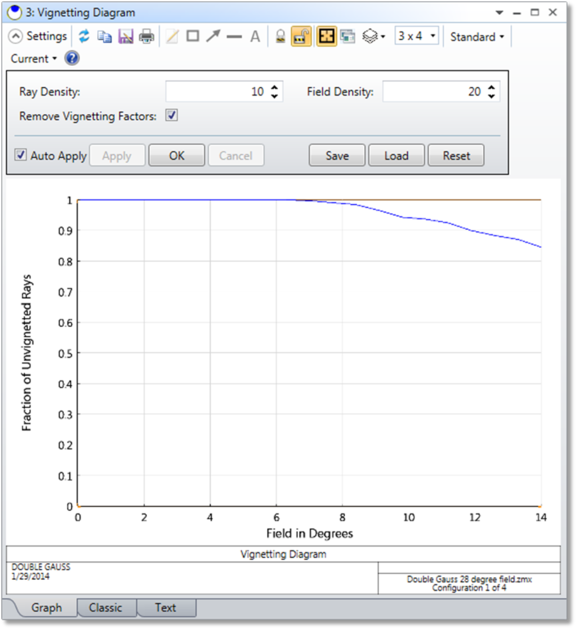Vignetting Plot
Calculates fractional vignetting as a function of field angle. This feature is appropriate for rotationally symmetric lenses and fields, as only positive y field angles at primary wavelength are used in this calculation. This is a geometric calculation.



Ray Density The Ray Density specifies the number of rays to be traced. The more rays traced, the greater the accuracy, although the computation time increases. For a Ray Density of n, OpticStudio traces a grid of (2n+1) x (2n + 1) Rays at each Field Point. The Ray Density minimum value is 5.
Field Density The field density is the number of points between zero degrees and the maximum field angle specified at which vignetting is calculated, intermediate values are interpolated.
Remove Vignetting Factors If checked, vignetting factors are automatically removed. See "Comment about vignetting factors".
Discussion Fractional vignetting is the percentage of rays incident upon the entrance pupil which pass all obscurations and apertures in the system and survive to the image surface, normalized to relative pupil area. The graphic generated by this function shows fractional vignetting as a function of field position. If too few rays are used, the results may be inaccurate. This is especially true in systems with many apertures and large field angles.
Rays which cause errors such as missing a surface or those which are TIR are considered vignetted.
See also "Relative Illumination"
Comment about vignetting factors
Vignetting factors determine the size and shape of the pupil as seen from different field points (see "Vignetting factors" for a full discussion). Because this analysis feature needs to trace rays at arbitrary intermediate field points where no specific vignetting factors are defined, the use of vignetting factors is not recommended. If "Remove Vignetting Factors" is checked on (the default), any defined vignetting factors will automatically be replaced with surface apertures for this computation. The surface aperture method is generally more accurate than the vignetting factor method when the pupil is overfilled with light. The resulting data may be different between the two methods. In some cases, particularly where the vignetting factors are being used to define the shape of the source beam rather than the apertures of the optics, it may be required to use the defined vignetting factors. In this case, check the "Remove Vignetting Factors" box off. OpticStudio will then use the closest defined field to determine the vignetting factors to use for an arbitrary field point.
Next:


